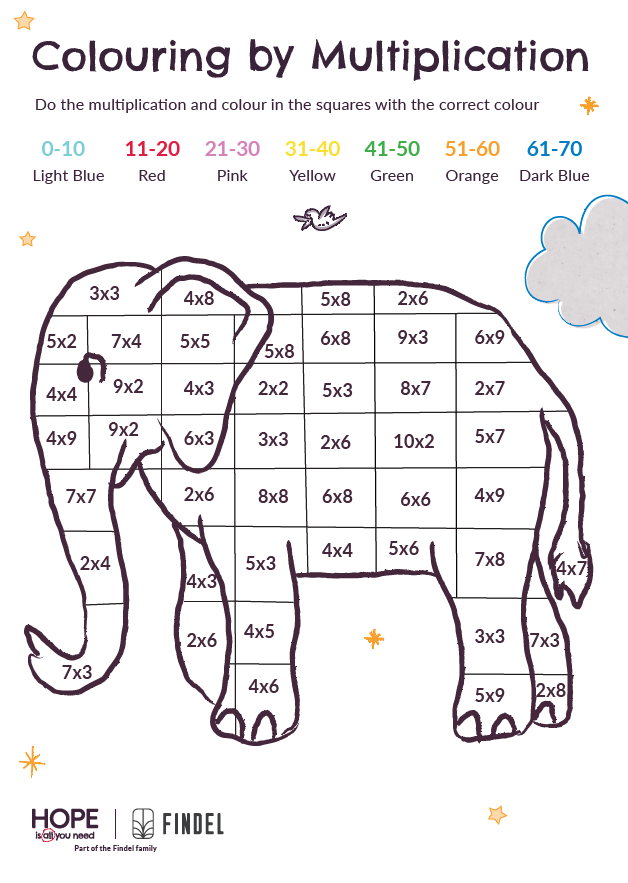5 tips & tricks to make learning times tables easier
Learning times tables can be difficult for children as they can become quite repetitive, leading to frustration. This is because times tables need to be covered regularly to help pupils develop their maths skills and work out problems quicker. However, there are ways to help make times tables easier for your pupils.
We have sourced 5 tips and tricks to make learning times tables easier for you to try out in your lessons. We have also created a fun colouring in worksheet to use as an engaging activity for children.
Learn & practice skip counting
One of the best ways to learn times tables is to use skip counting. Teach children how to skip count and practice it often so that they can grasp the concept. This can aid them in their times tables. Skip counting is when you start with the number you’re counting by and keep adding the same number to it. As an example, if you started with 2, it would go 2,4,6,8,10,12,14 etc… Doing this is already saying times tables out loud with little effort once pupils know how.
To help children memorise skip counting, you could play a tune in the background and fit the counting to the tune. Doing this can boost pupils’ memory skills and make times tables a whole lot easier.
Use a times tables grid
Sometimes a traditional technique can be most effective to help learn times tables. Download a worksheet or create your own times tables grid on an A3 piece of paper. Go through it with your class and fill it in, or make individual ones to challenge children. Once completed, display the grid at the front of the classroom where pupils can see it often to memorise times tables.
Set a regular time during your week’s preparations when you can focus on the grid with your pupils. Each time you run through this grid, focus on one timetable at a time. This could be a certain times table that most of your class are struggling with. The more often your pupils run through this grid, the more likely they will learn and memorise times tables.
Break into small steps
This is probably the easiest way to help children learn their times tables, but it is vital. Don’t overwhelm pupils with lots of times tables all at once. Break them up into small steps and cover them one at a time to help them retain the information. When doing this ensure say the times table in its sequence, for example, clearly saying 1×5 is… 2×5 is… 3×5 is etc.
Breaking up each times table this way makes multiplication feel much more achievable for children. You could help this further by allowing stepping stones to be used when figuring out a more difficult multiplication. For example, children can often find 6 x 8 hard to work out but they will instantly know 5 x 8. This is because the 5 times tables are learnt from an early age, so they are more easily remembered. From taking a stepping stone at 5 x 8 they can be encouraged to work out 6 x 8 as it is only eight more than 5 x 8. You can guide pupils to add 8 more onto 5 x 8 to get their answer and encourage them to do this with more times tables they get stuck with.

Use the multiplication flower technique
Let children get creative by using the multiplication flower technique to help them learn times tables. Children can draw the centre of the flower to begin with and write a number between 2 to 12 inside. You could do a random generator to help choose the number you want pupils to focus on or let them pick.
Then, they simply draw 12 petals around the centre and number it from 1 to 12. Finally, tell them to draw another 12 petals around the flower and ask them to multiply the middle number and the inner petals. They can write their answers inside the outside petals and then lightly colour their flowers in when finished. This exercise can be done daily to help children grasp times tables.
Offer rewards
A great way to encourage children to keep on practising times tables and help their enthusiasm a little is by offering small rewards when possible. There’s no harm in occasionally treating your pupils for their hard work and effort to boost their morale and determination to learn times tables. Children often find times tables tedious and can easily get frustrated when learning them. This is because it needs to be covered over and over to memorise and learn how multiplication works.
Stock up on a few sweet treats or stickers to hand to your pupils when they need the boost. It could be if you notice most of the class becoming bored or frustrated when going through the 8 times table. Remember to treat all children together when it comes to rewarding learning. Rewards shouldn’t just be given to pupils who have done well, but they should also be given to children who have tried their hardest. It’s important to reward pupils’ effort rather than the outcome of their work to encourage them to strive for success.
Download our free times tables colouring in sheet!
Another fantastic way of learning times tables is by using a multiplication colouring in sheet. Download our free and fun elephant multiplication worksheet for children to colour by numbers with.
All they have to do is work out each sum and colour the block with the correct answer colour. Using this worksheet is great for aiding pupils with understanding times tables and multiplication. Plus, it’s great for boosting children’s memory skills when it comes to times tables. They can associate certain multiplications with a colour which sticks in their mind easier.
Try this fun and engaging free worksheet now by downloading here.
Integrate these 5 tips and tricks to make learning times tables easier into your lesson plans and make time to do these regularly. Learning and practicing times tables is essential for children to be able to understand how they work. This can also help with correctly answering multiplications as times tables are designed to teach children how to solve problems easier and quicker. These tips can also develop children’s memory skills, which is vital for their future.
Want some more fun maths activities and tips? Check out our fun outdoor maths activities blog.
